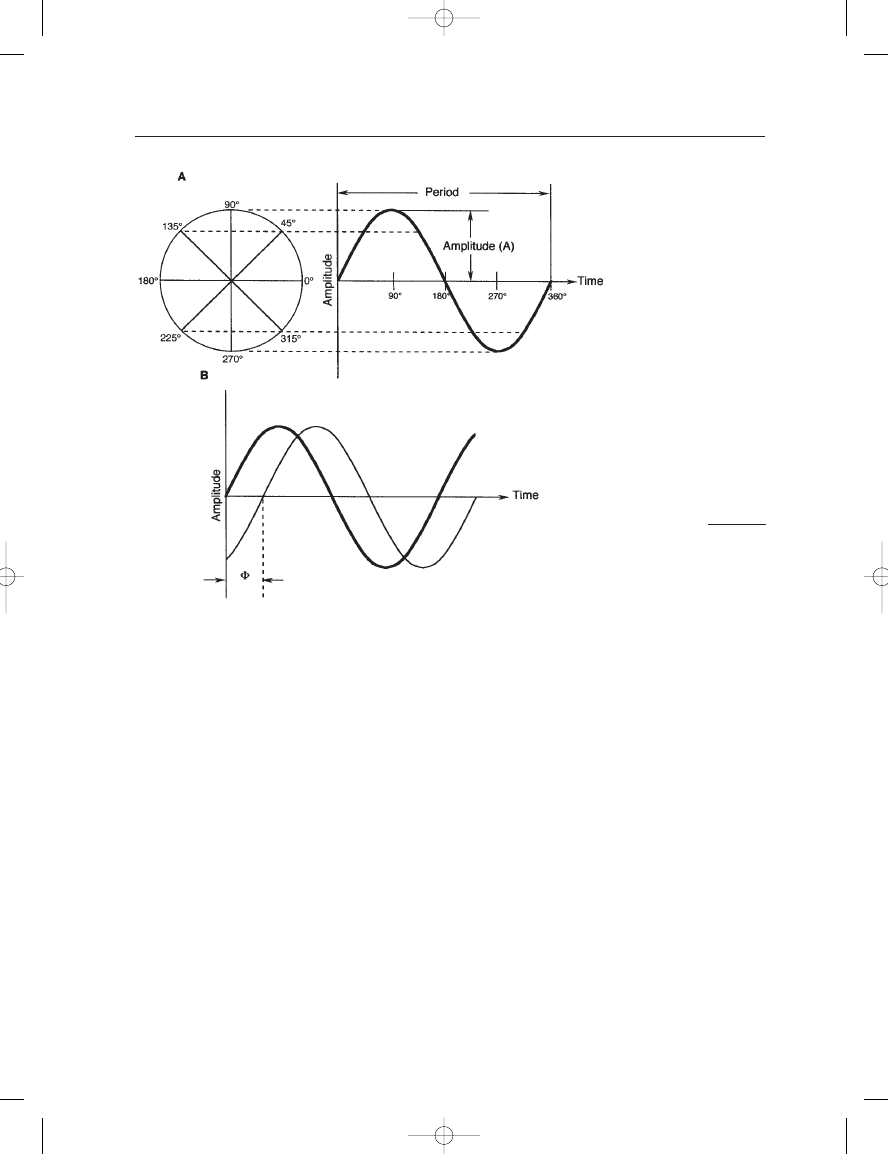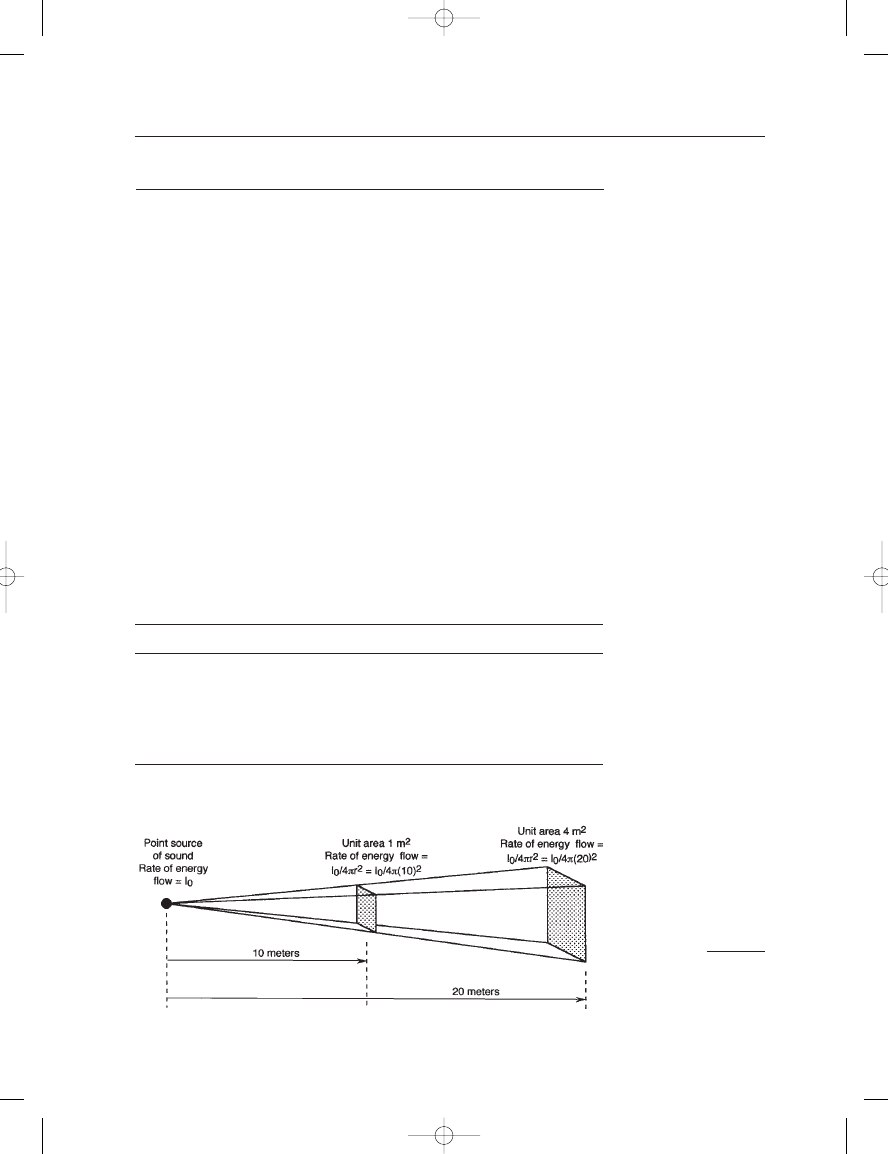ВУЗ: Казахская Национальная Академия Искусств им. Т. Жургенова
Категория: Книга
Дисциплина: Не указана
Добавлен: 03.02.2019
Просмотров: 17453
Скачиваний: 51

THE MICROPHONE BOOK
8
For sine waves radiating outward in a physical medium such as air,
the baseline in Figure 2–1 represents the static atmospheric pressure,
and the sound waves are represented by the alternating plus and minus
values of pressure about the static pressure. The period then corresponds
to wavelength, the distance between successive iterations of the basic
waveform.
The speed of sound transmission in air is approximately equal to
344 meters per second (m/s), and the relations among speed (m/s), wave-
length (m), and frequency (1/s) are:
c (speed)
f (frequency) (wavelength)
f
c/
c/f
(2.1)
For example, at a frequency of 1000 Hz, the wavelength of sound in air
will be 344/1000
0.344 m (about 13 inches).
Another fundamental relationship between two waveforms of the
same frequency is their relative phase (
), the shift of one period relative
to another along the time axis as shown in Figure 2–1B. Phase is nor-
mally measured in degrees of rotation (or in radians in certain mathe-
matical operations). If two sound waves of the same amplitude and
FIGURE 2–1
Generation of a sine
wave signal (A); phase
relationships between two
sine waves (B).
Earg_02.qxd 14/9/04 2:35 PM Page 8

2: Basic Sound Transmission and Operational Forces on Microphones
9
frequency are shifted by 180
they will cancel, since they will be in an
inverse (or anti-phase) relationship relative to the zero baseline at all
times. If they are of different amplitudes, then their combination will not
directly cancel.
The data shown in Figure 2–2 gives the value of wavelength in air
when frequency is known. (By way of terminology, velocity and speed
are often used interchangeably. In this book, speed will refer to the rate
of sound propagation over distance, while velocity will refer to the
specifics of localized air particle and air volume movement.)
TEMPERATURE DEPENDENCE OF SPEED OF
SOUND TRANSMISSION
For most recording activities indoors, we can assume that normal tem-
peratures prevail and that the effective speed of sound propagation will
be as given above. There is a relatively small dependence of sound prop-
agation on temperature, as given by the following equation:
Speed
331.4 0.607 C m/s (2.2)
where
C is the temperature in degrees celsius.
FIGURE 2–2
Wavelength of sound in air
versus frequency; in meters
(A); in feet (B).
Earg_02.qxd 14/9/04 2:35 PM Page 9

THE MICROPHONE BOOK
10
ACOUSTICAL POWER
In any kind of physical system in which work is done, there are two
quantities, one intensive, the other extensive, whose product determines
the power, or rate at which work is done in the system. One may intu-
itively think of the intensive variable as the driving agent and the exten-
sive variable as the driven agent. Table 2–1 may make this clearer.
Power is stated in watts (W), or joules/second. The joule is the unit
of work or energy, and joules per second is the rate at which work is
done, or energy expended. This similarity among systems makes it easy
to transform power from one physical domain to another, as we will see
in later chapters.
Intensity (I) is defined as power per unit area (W/m
2
), or the rate of
energy flow per unit area. Figure 2–3 shows a sound source at the left
radiating an acoustical signal of intensity I
0
uniformly into free space.
We will examine only a small solid angle of radiation. At a distance of
10 m that small solid angle is radiating through a square with an area of
1 m
2
, and only a small portion of I
0
will pass through that area. At a dis-
tance of 20 m the area of the square that accommodates the original solid
angle is now 4 m
2
, and it is now clear that the intensity at a distance of
20 m will be one-fourth what it was at 10 m. This of course is a neces-
sary consequence of the law of conservation of energy.
TABLE 2–1
Intensive and extensive variables
System
Intensive variable
Extensive variable
Product
Electrical
voltage (e)
current (i)
watts (e
i)
Mechanical
force (f )
velocity (u)
watts (f
u)
(rectilinear)
Mechanical
torque (T)
angular velocity (
)
watts (T
)
(rotational)
Acoustical
pressure (p)
volume velocity (U)
watts (p
U)
FIGURE 2–3
Sound intensity variation
with distance over a fixed
solid angle.
Earg_02.qxd 14/9/04 2:35 PM Page 10

2: Basic Sound Transmission and Operational Forces on Microphones
11
The relationship of intensity and distance in a free sound field is
know as the inverse square law: as intensity is measured between dis-
tances of r and 2r, the intensity changes from 1/I
0
to 1/4I
0
.
The intensity at any distance r from the source is given by:
I
W/4r
2
(2.3)
The effective sound pressure in pascals at that distance will be:
(2.4)
where
0
c is the specific acoustical impedance of air (405 SI rayls).
For example, consider a point source of sound radiating a power of
one watt uniformly. At a distance of 1 meter the intensity will be:
I
1/4(1)
2
1/4 0.08 W/m
2
The effective sound pressure at that distance will be:
RELATIONSHIP BETWEEN AIR PARTICLE
VELOCITY AND AMPLITUDE
The relation between air particle velocity (u) and particle displacement
(x) is given by:
u(t)
j (t)
(2.5)
where
2f and x(t) is the maximum particle displacement value. The
complex operator j produces a positive phase shift of 90
.
Some microphones, notably those operating on the capacitive or
piezoelectric principle, will produce constant output when placed in a
constant amplitude sound field. In this case u(t) will vary proportional to
frequency.
Other microphones, notably those operating on the magnetic induc-
tion principle, will produce a constant output when placed in a constant
velocity sound field. In this case, x(t) will vary inversely proportional to
frequency.
THE DECIBEL
We do not normally measure acoustical intensity; rather, we measure
sound pressure level. One cycle of a varying sinusoidal pressure might look
like that shown in Figure 2–4A. The peak value of this signal is shown as
unity; the root-mean-square value (rms) is shown as 0.707, and the aver-
age value of the waveform is shown as 0.637. A square wave of unity
value, shown at B, has peak, rms, and average values that all are unity. The
rms, or effective, value of a pressure waveform corresponds directly to the
power that is delivered or expended in a given acoustical system.
The unit of pressure is the pascal (Pa) and is equal to one newton/m
2
.
(The newton (N) is a unit of force that one very rarely comes across in
p
(0.08)405
5.69
Pa
p
I
0
c
Earg_02.qxd 14/9/04 2:35 PM Page 11

THE MICROPHONE BOOK
12
daily life and is equal to about 9.8 pounds of force.) Pressures encoun-
tered in acoustics normally vary from a low value of 20
Pa (micropas-
cals) up to normal maximum values in the range of 100 Pa. There is a
great inconvenience in dealing directly with such a large range of num-
bers, and years ago the decibel (dB) scale was devised to simplify things.
The dB was originally intended to provide a convenient scale for looking
at a wide range of power values. As such, it is defined as:
Level (dB)
10 log (W/W
0
)
(2.6)
where W
0
represents a reference power, say, 1 watt, and the logarithm is
taken to the base 10. (The term level is universally applied to values
expressed in decibels.) With one watt as a reference, we can say that
20 watts represents a level of 13 dB:
Level (dB)
10 log (20/1) 13 dB
Likewise, the level in dB of a 1 milliwatt signal, relative to one watt, is:
Level (dB)
10 log (0.001/1) 30 dB
From basic electrical relationships, we know that power is propor-
tional to the square of voltage. As an analog to this, we can infer that
acoustical power is proportional to the square of acoustical pressure. We
can therefore rewrite the definition of the decibel in acoustics as:
Level (dB)
10 log (p/p
0
)
2
20 log (p/p
0
)
(2.7)
In sound pressure level calculations, the reference value, or p
0
, is estab-
lished as 0.00002 Pa, or 20 micropascals (20
Pa).
Consider a sound pressure of one Pa. Its level in dB is:
dB
20 log (1/0.00002) 94 dB
This is an important relationship. Throughout this book, the value of 94
dB L
P
will appear time and again as a standard reference level in micro-
phone design and specification. (L
P
is the standard terminology for sound
pressure level.)
Figure 2–5 presents a comparison of a number of acoustical sources
and the respective levels at reference distances.
FIGURE 2–4
Sine (A) and square (B)
waves: definitions of peak,
rms and average values.
Earg_02.qxd 14/9/04 2:35 PM Page 12